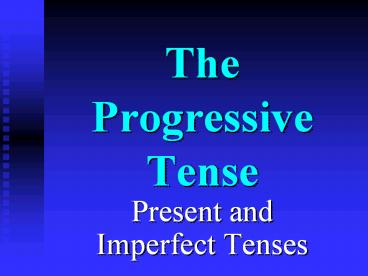The%20Progressive%20Tense - PowerPoint PPT Presentation
Title:
The%20Progressive%20Tense
Description:
The Progressive Tense Present and Imperfect Tenses To describe in Spanish an action that is taking place as you speak use the present progressive (presente progresivo). – PowerPoint PPT presentation
Number of Views:234
Avg rating:3.0/5.0
Title: The%20Progressive%20Tense
1
The Progressive Tense
- Present and Imperfect Tenses
2
- To describe in Spanish an action that is taking
place as you speak use the present progressive
(presente progresivo). To do so - - Use the form of estar (to be) that agrees with
the subject a present participle (gerundio).
(-ing in English)
3
- Qué está haciendo Chela?
- What is Chela doing right now?
- Qué haces Chela?
- What is Chela doing?(this weekend..tonight etc.)
4
- In Spanish, the present progressive describes an
action that is ocurring right now. To describe
actions going on in the general present, use the
present tense.
5
Compare the following sentences
- Patricia está escribiendo una carta.
- Patricia is writing a letter. (RIGHT NOW.)
- Stephen King escribe otra novela.
- Stephen King is writing another novel. (THIS YEAR)
6
ESTAR to be
yo nosotros
tú vosotros
él/ella usted ellos/as ustedes
- estoy
estamos
estáis
estás
está
están
7
- In Spanish, the imperfect progressive is used to
describe something that was taking place over a
period of time in the past. - Ex Estaba esquiando cuando me caí y me torcí la
rodilla. - I was skiing when I fell and twisted my knee.
8
- Note that the imperfect progressive describes
what was taking place while the preterite tells a
specific occurrence in the past or interrups the
action. - Ex Estaba esquiando cuando me caí y me torcí la
rodilla. - I was skiing when I fell and twisted my knee.
9
- Note that the imperfect progressive describes
what was taking place while the preterite tells a
specific occurrence in the past or interrups the
action. - Ex Ella estaba corriendo cuando se lastimó el
tobillo. - She was running when I she injured her ankle.
10
- It is never wrong to use just the imperfect
instead of the imperfect progressive when talking
about an ongoing action. You can choose either.
The progressive tense puts a little more emphasis
on the ongoing action but either is OK. - Ex Ella estaba corriendo cuando se lastimó el
tobillo. - Ex Ella corría cuando se lastimó el tobillo.
- She was running when
11
- Ex Estaba esquiando cuando me caí y me torcí la
rodilla. - Ex Esquiaba cuando me caí y me torcí la rodilla.
- I was skiing when
- But remember in the present tense, you can ONLY
use the progressive tense when the action is
going on right now. Since both the imperfect
and the imperfect progressive are both in the
past than the right now rule is no longer
relevant.
12
To form a present participle
- 1. Drop the ending (-ar, -er, ir) from the
infinitive. (Leaving the stem.) - 2. Add ando to the stem of ar
- verbs.
- Add iendo to the stem of er
- or ir verbs.
- This is the equivalent of the ing form of the
verb in English.
13
- So basically, you are adding NDO to the verb to
make it the equivalent to ING in English. - For -AR VERBS
- For -IR and - ER VERBS
NDO
A
NDO
IE
14
- jugar
jug ando
jugando
(playing)
- comer
com iendo
comiendo
(eating)
- escribir
escrib iendo
escribiendo
(writing)
15
Subject ESTAR ando
iendo
- Estar will be conjugated to match the subject of
the sentence.(gerund never changes - Estoy hablando.(I am talking.)
- Ella está comiendo. (She is eating.)
16
- If the stem of an er or ir verb ends in a
vowel, - -iendo changes to yendo.(i y)
- leer
- traer
- oír
- creer
leyendo (reading)
trayendo(bringing)
oyendo (hearing)
creyendo (believing)
17
- All -ir verbs that normally change from e?ie in
the present will change from e?i in the past
participle (just like in the preterite sandal). - divertir ? divirtiendo
- sentir ? sintiendo
18
- The following -irverbs normally change from e?i
in the present and the participles (just like in
the sandal). - decir diciendo
- pedir pidiendo
- repetir repitiendo
- seguir siguiendo
- servir sirviendo vestirvistiendo
19
- All -ir verbs that normally change from o?ue in
the present will change from o?u in the past
participle (just like in the preterite sandal). - dormir ? durmiendo
- morir ? muriendo
20
-ir stem-changing verbs
- The following verbs normally change from o?ue in
the present but only o?u in the participle. - dormir
- morir
21
- Pronouns can either go before estar (the
conjugated verb) or attached to the participle. - ducharse
- Me estaba duchando.
- Estaba duchándome.
22
- Im doing it. (la tarea)
- La estoy haciendo.
- Estoy haciéndola.
- NOTE When attaching a pronoun you add an accent
to the a of -ando and the e of iendo.































